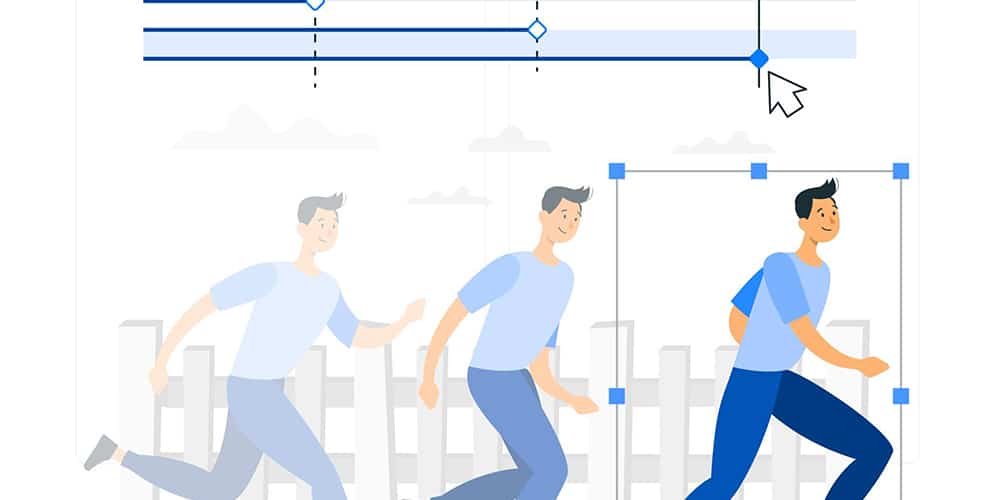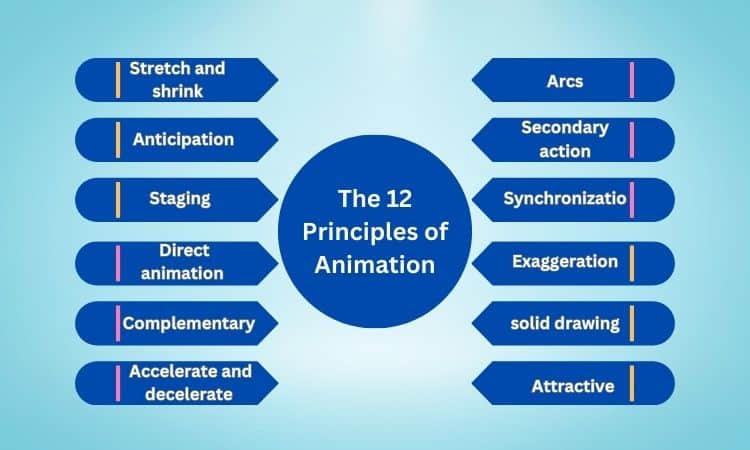
The 12 Principles of Animation
The 12 Principles of Animation
Every profession or trade requires basic rules or at least a common language to unify some criteria. In most cases, there is an elementary guide that allows the development of this activity, facilitating the way for new generations. That guide, who has been shaped by those who experience, has allowed them to innovate and wish to transmit that knowledge. Animation does not escape this, although we always seek to renew in this industry, it is important to maintain some aspects and respect them whether we do traditional animation or if we are a motion Graphics Company, our duty is to know the principles that govern our field.
What are the 12 principles of animation?

This is how in 1981, animators Ollie Johnston and Frank Thomas of Walt Disney Animation Studio presented their book ‘The Illusion of Life: Disney Animation’. In this work, they compiled the experience obtained in Disney studios since 1930. Since then, it has been considered one of the main lessons to be taught among animators who begin their journey in this fascinating world.
This great legacy has left us with 12 principles of animation that should follow every animated story, at least in its traditional conception and that allows its adaptation to 3D animation. These are a series of rules and guidelines that are still very valid today. Originally they were intended to be applied in Disney cartoons, but much of what they propose is perfectly extrapolated to Japanese animation.
Without further ado, let’s see each of these principles.
Stretch and shrink / Compression and extension (Squash & stretch)
This principle adds to the idea of weight and flexibility. Stretching and shrinking consist of deforming the object of animation, increasing the sensation of movement. In turn, a more comical or dramatic effect is created. It is the technique that gives the object a feeling of flexibility, from a bouncing ball to the stretching of a figure or character to produce a comic effect.
Anticipation
Anticipation helps guide the viewer’s gaze to where the action is about to occur. In other words, the observer is prepared for an action which makes the realization more realistic. Thus we have that, through this technique, we seek to keep the audience expectant. With this technique, the animator intends to anticipate an action that is going to happen, such as a look of a character outside the scene, or a jump anticipating him bending his knees. Through this technique, it is intended to keep the audience expectant before a new event.
Staging
Among the 12 principles of animation, this is to direct or define the most important in the field of view of the observer. This can be done using lights, shadow, and boxes, among others. The objective is to make clear the idea of what happens on stage. It is based on the presentation of an idea in a clear way so that the viewer does not get distracted and focuses on the really important part of the scene. The use of the lights and shadows, the expressions and position of the characters involved, etc. They are some of the techniques used.
Direct animation and pose to pose
They are two different animation techniques. The direct involves drawing a scene frame by frame from beginning to end. It creates an illusion of fluidity and dynamism in the movement, allows producing realistic sequences, although it is difficult to maintain precise proportions and perspectives.
Direct animation is based on directly drawing a scene frame by frame from beginning to end, creating a more fluid and realistic scene. For its part, the pose-to-pose technique is based on drawing the key poses of the characters and then completing them with the secondary poses; it saves work but makes it more difficult to create compelling poses. Usually, these two techniques are usually combined.
Complementary and overlapping actions (Follow through & overlapping)
They are closely related animation techniques since they help to give realism to the movement and provide the illusion that an object moves to respect the principle of inertia. With the complementary action, the detached pieces of the object must continue their movement even after the object stopped moving. While the superimposed action is applied when the different elements of the object move in different ways, depending on their relationship with the main object and the speed at which it moves. Both techniques make the movement more realistic. The complementary action is based on what elements outside the body of the character must continue in the independent movement even if the character stops moving. On the other hand, the superimposed action refers to the different elements of the body of the character that must be moved differently, the movement of an arm is not the same as that of the hair or clothes.
Accelerate and decelerate / Slow Inputs and Slow Outputs / Ease In – Ease Out
In reality, objects do not pass from absolute rest to continuous movement in one step. On the contrary, it takes time to speed up or slow down. In this sense, a starting and braking effect that gives more realism must be created. It applies to both characters and objects to create naturalness. It is carried out by creating more movement at the beginning of the action and at the end. This gives prominence to the key pose.
Arcs
In the real world, movements generally follow a circular path, very few things move in a straight line, the same should happen in an animated story. Without this element, the created would feel rigid and mechanical. So they must create arcs in the movements of the characters. This technique is based on natural movements to follow a circular path. So any movement will have to have some curvature to give the feeling of realism. As an exception to this principle are strong movements since these normally occur in straight lines.
Secondary action
The main action can be emphasized by adding additional movements. The secondary action should never be marked more than the dominant action so that the viewer is not distracted consists of adding secondary actions to the main action. Thus giving more emphasis to the main action that is more enriched.
Synchronization (Timing)
It refers to the times when something happens in the animation. This element adds rhythm and emotion to the work. It is directly related to the speed of the action in the scene, that is, it determines the rhythm and duration in which a character performs the action. This technique allows creating humor and emotions in a character. It has to do with the speed of the action in a scene that adjusts with the number of frames that are added. This technique is important to create humor and emotions in a character.
Exaggeration
The exaggeration presents the characteristics and actions of the characters in an extreme way to achieve a comic or dramatic effect. With this resource, the emotional appeal is increased and the narrative is exalted. However, it is important to maintain harmony between the elements using the technique with a specific objective. This is a resource widely used in animated films but you have to be very careful not to ruin the truth of the scene, you must maintain a harmony between the elements and use the technique of exaggeration with the specific objective that we have set.
Solid / solid drawing
It means, represent shapes giving the illusion of volume and weight on a flat-screen. To achieve this it is necessary to apply basic concepts such as perspective, volume, weight, balance, lighting, etc. The creation of three-dimensional space of the drawings will help us see in 3D. To do this you have to take into account the volume and weight of the character to avoid falling into symmetry. Another aspect to take into account is that the assembly must maintain consistency and be consistent both in an individual pose and with all those that make up that animation.
Attractive (Appeal)
Finally, the last principle, it has to do with what the spectators will remember at the end of the work. The characters that feel real, interesting and attractive are the ones remembered which is what we would call the character’s charisma. What is sought is that the public connects with those characters. After all, the task of the animator is to give soul and life to a character. The appearance must also be solid and attractive.
So far they have brought us these 12 principles of traditional animation, which every animator must follow to adapt it to their needs and what they want to convey. This legacy, which left great animation should not be taken as unbreakable rules, on the contrary, they should be a guide that will allow you to obtain the best possible results. In addition, we must not lose sight of the fact that technology is advancing and to that extent, we must have an open mind to adapt and reinterpret these principles to the new times.
If you are interested in the world of animation, you can train with us through the BVA Degree in Animation & Multimedia Design; it is a 4 year degree program. We are also affiliated to Bangalore Central University. There is also Diploma in animation and many other short term courses in animation offered by the college.
Courses Provided by Animaster
As one of the best Animation College in Bangalore Animaster provides best and full fledged courses.
These courses are fully professional courses which will provide an Animation Degree in Bangalore are:
- Bsc visual communication
- BA Visual Communication
- Bsc Viscom
Whether you want to learn animation or learn Graphic Design and go to Graphic Design Classes or pursue a full animation course, Animaster will provide these courses to become true professionals in animation.
FAQs
Ques: 1 What are the 12 principles of animation and who created them?
Ans: The 12 principles of animation are the real guidelines for the creation of appealing and realistic animations. These guidelines were developed by Frank Thomas and Ollie Johnston from the Disney group, through their book “ The Illusion of Life”
Ques: 2 What are the best industries where the animators can work?
Ans: Being an animator there is a vast scope of career opportunities that are available for the candidates. They can work in animation, filmmaking, video gaming, graphics, TV, and advertising. They can also work in architecture or medical fields as well. They can be freelancers as well and work in studios.
Ques:3 How can Animaster help you master the 12 principles of animation?
Ans: Animaster will help you master the 12 principles of animation with the help of a deep and well-researched curriculum along with the practical projects based on these 12 principles. You will get great industry exposure and expert guidance based on it.
For more details please visit our website www.animaster.com



